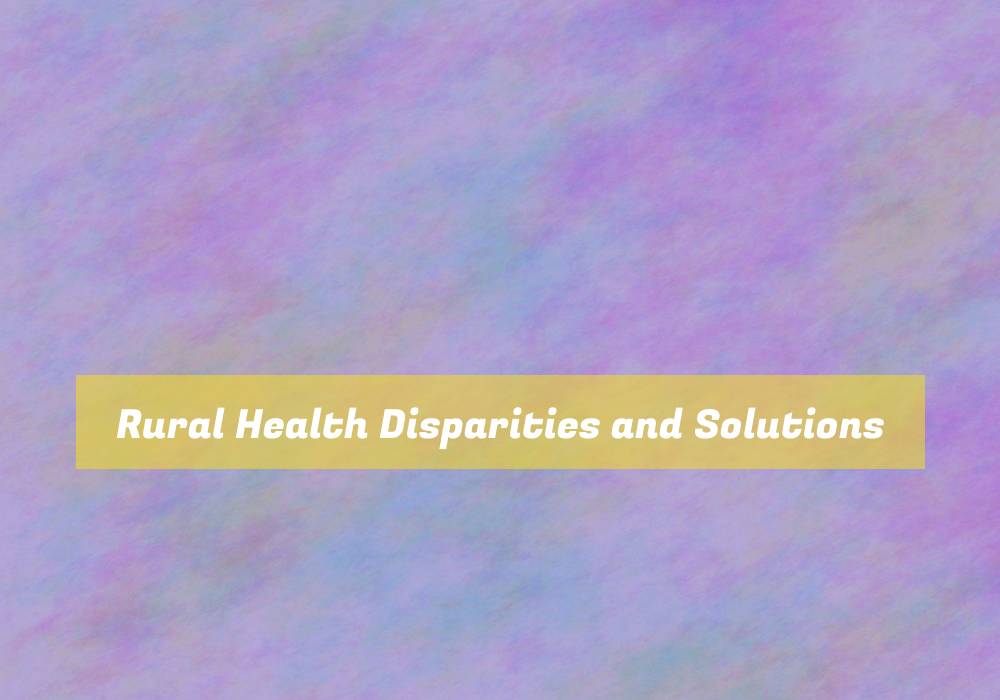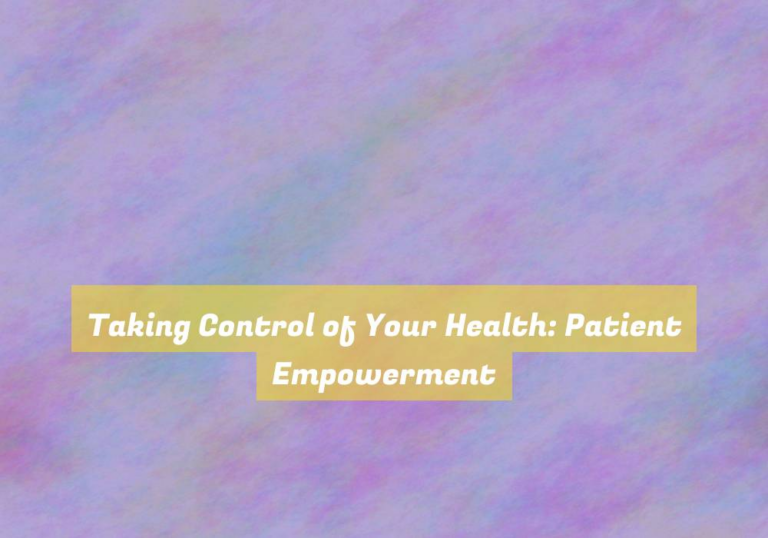Rural Health Disparities and Solutions
Did you know that rural residents are 5% more likely to die from preventable causes compared to their urban counterparts?
The disparity in healthcare access and outcomes between rural and urban areas is a pressing issue that demands attention. But what are the underlying reasons for this disparity, and what innovative solutions are being implemented to address these challenges?
LetG??s explore the complex landscape of rural health disparities and the promising strategies aimed at promoting health equity in these underserved areas.
Understanding Rural Health Disparities
To understand rural health disparities, itG??s important to recognize the unique challenges faced by individuals in rural areas when accessing healthcare.
In rural areas, access to healthcare facilities is often limited, with fewer hospitals and medical professionals available. This scarcity can result in longer travel times to reach healthcare providers, leading to delays in receiving necessary medical attention.
Additionally, rural areas often have lower income levels and higher rates of uninsured individuals, making it difficult for residents to afford healthcare services. The shortage of healthcare providers in rural areas also means that those who do seek medical care may encounter longer wait times for appointments and treatments.
Furthermore, the lack of specialized medical services in rural areas can result in patients needing to travel long distances to access certain treatments, causing additional financial and logistical burdens. The combination of these factors contributes to rural health disparities, as individuals in these areas face significant obstacles in obtaining timely and affordable healthcare.
Understanding these challenges is crucial in developing effective solutions to address rural health disparities and ensure that all individuals have access to the healthcare they need.
Barriers to Accessing Healthcare
Addressing the challenges faced in rural areas to access healthcare, itG??s crucial to recognize the barriers that individuals encounter when seeking medical services. One major barrier is the geographic distance to healthcare facilities. In rural areas, medical facilities are often few and far between, requiring individuals to travel long distances to receive care. This can be particularly challenging for those without access to reliable transportation, leading to delayed or forgone medical treatment.
Another significant barrier is the shortage of healthcare providers in rural areas. Many rural communities struggle to attract and retain healthcare professionals, resulting in limited availability of medical services. This shortage not only affects the accessibility of primary care but also specialty care, forcing individuals to seek treatment outside of their local communities.
Additionally, financial constraints can pose a significant obstacle to accessing healthcare in rural areas. Limited financial resources and lack of health insurance coverage can deter individuals from seeking necessary medical attention, leading to unmet healthcare needs.
Lastly, inadequate health literacy and awareness about available healthcare services can prevent individuals from seeking timely medical care, exacerbating health disparities in rural areas. Efforts to address these barriers must include strategies to improve transportation options, expand the healthcare workforce in rural areas, increase financial assistance programs, and enhance health education initiatives to ensure equitable access to healthcare for all rural residents.
Innovative Solutions and Interventions
Amidst the challenges of rural healthcare access, innovation stands as a beacon of hope, offering creative solutions to bridge the gap in medical services. One promising intervention is the use of telemedicine, which enables individuals in remote areas to consult with healthcare professionals through video calls, reducing the need for long and often costly travel.
Mobile health clinics are another innovative solution, bringing medical services directly to rural communities. These clinics offer a range of services, from preventive care to chronic disease management, addressing the healthcare needs of underserved populations.
Furthermore, the use of community health workers has shown great promise in rural areas. These individuals, often from the same community, are trained to provide basic healthcare services, health education, and support to community members. This approach not only improves access to care but also fosters trust and understanding within the community.
Innovative financing models, such as pay-for-performance and value-based care, are also being explored to incentivize healthcare providers to deliver high-quality care in rural areas. These models aim to improve health outcomes while controlling costs, ultimately ensuring that rural residents receive the care they need.
Promoting Health Equity in Rural Areas
Promoting health equity in rural areas requires a multifaceted approach that addresses the unique challenges faced by these communities.
Access to healthcare is a critical issue in rural areas, where geographic isolation and a shortage of healthcare facilities and providers can impede the delivery of medical services. To address this, telemedicine and mobile clinics can be utilized to bridge the gap and bring essential healthcare services directly to rural residents.
Additionally, thereG??s a need to focus on socioeconomic factors that contribute to health disparities. This involves addressing poverty, improving access to healthy food options, and creating economic opportunities within rural communities.
Education and outreach programs tailored to the specific needs of rural populations are also essential for promoting health equity. By raising awareness about preventive care, chronic disease management, and mental health resources, these initiatives can empower individuals to take control of their health.
Ultimately, promoting health equity in rural areas requires a comprehensive strategy that encompasses healthcare access, socioeconomic factors, and community education to ensure that all individuals, regardless of location, have the opportunity to lead healthy lives.
Conclusion
In conclusion, addressing rural health disparities requires recognizing the barriers to accessing healthcare and implementing innovative solutions.
By promoting health equity in rural areas, we can work towards closing the gap in healthcare outcomes.
ItG??s important to continue advocating for resources and support to ensure that all individuals, regardless of their location, have access to the healthcare they need to thrive.







This is a really important topic, and I appreciate you shedding light on it. It makes me think about my own experiences growing up in a small town where access to healthcare was a constant concern. We had one small clinic, and if you needed anything more serious, you were looking at a long drive to a city, which wasn’t just inconvenient but often a bit daunting, especially for older residents or those without reliable transportation.
It sounds like your experiences really highlight the challenges many face in small towns when it comes to healthcare. That long drive to a city for more comprehensive services isn’t just a logistical hurdle; it can create a barrier to receiving timely care, which is crucial, especially for older residents or those who may struggle with transportation.
You make such a good point about the logistical challenges of healthcare in small towns. That long drive really can feel overwhelming, especially when every minute counts for someone dealing with health issues. I’ve spoken with older neighbors who have shared how that commute not only impacts their physical health but also adds so much stress to their lives. It’s one thing to navigate everyday tasks, but when you layer on the need for more comprehensive medical care, it can feel insurmountable.
I recently came across some insights on how access to healthcare varies globally, which really resonates with the challenges faced in small towns—especially the struggle for timely services that many residents encounter.
‘Breaking Barriers: Access to Healthcare in Different Parts of the World’
https://www.global-ehealth-forum.com/2023/02/09/breaking-barriers-access-to-healthcare-in-different-parts-of-the-world/.
You’ve beautifully captured the heart of the issue. The long drives to access healthcare can be such a significant burden, especially for older individuals who are already facing various health challenges. That added stress can indeed create a ripple effect on their overall well-being.
You’ve touched on a vital aspect of healthcare that often gets overlooked, especially in discussions focused solely on urban settings. The fact that so many individuals in small towns have to contend with physical and emotional stress while driving long distances for care is significant. It goes beyond just logistics; it deeply affects their overall quality of life. The layers of stress added by lengthy commutes can exacerbate existing health conditions, making it all the more crucial that we address these disparities.
You’ve articulated a really important concern about healthcare access in rural areas. The long distances that people in small towns have to travel for medical care indeed create a host of additional challenges. It’s not just about the physical act of driving; there’s a mental toll that comes with it, too. I recently read about a community health initiative in a rural area that introduced telehealth services, which seems to address some of these accessibility issues. It provides patients with a way to receive care without the stress of a lengthy commute.
You’ve highlighted a critical aspect of rural healthcare that resonates deeply with many, myself included. The distance people have to travel for medical care isn’t just a logistical issue; it’s a barrier that impacts overall well-being and peace of mind. Long drives can be exhausting, and when you factor in the frustrations of navigating unfamiliar roads or unreliable weather, it can really amplify feelings of anxiety and stress.
You raise a valid point about the mental burden of travel for healthcare, which often gets overshadowed by the logistical challenges. Telehealth has been a game changer for many. However, it’s worth considering that while some people may find virtual visits easier, others might struggle with technology or lack reliable internet access, particularly in very remote areas. It’s not a one-size-fits-all solution.
Your experiences really highlight a crucial aspect of healthcare in smaller communities that often gets overlooked. Growing up in a small town certainly comes with its own set of charms, but reliable access to healthcare can be a real challenge. The situation you describe—relying on a single clinic and making long treks for more serious care—resonates with many people in similar rural settings.
It’s true, the charm of small towns can sometimes hide the struggles people face when it comes to healthcare. Relying on a single clinic means you get to know the staff well, but it can also create a sense of vulnerability when more serious health issues arise. I remember growing up, my family and I relied heavily on our local clinic, and there were definitely moments when it felt like a gamble. Trips to the nearest hospital could mean an hour or more on the road, and in a small community, there’s a certain pressure to tolerate discomfort rather than make that journey for what might seem like a minor issue.
Your experiences resonate deeply, and it’s striking how many people share similar stories. In small towns, healthcare challenges can feel like a significant hurdle, especially when you’re relying on just one clinic. That long drive to the city really adds to the stress for many, particularly for older residents or those without reliable transport.
It’s definitely true that the healthcare landscape can feel especially daunting in small towns, and your point about relying on just one clinic really hits home. There’s a certain comfort in familiar faces at a local clinic, but that can quickly turn into a bottleneck when there are ongoing challenges or when specialty care is needed. The reliance on just one clinic can lead to a sense of vulnerability for many, and that stress is amplified when a drive to the city is involved.
You hit the nail on the head. Those long drives really can take a toll, especially for older folks who might find navigating the city overwhelming. I’ve seen it firsthand—people missing appointments simply because getting there felt like too big of a challenge. It’s not just about distance; it’s the uncertainty and the time away from the comforts of home that can be daunting.
It sounds like you experienced firsthand the complexities of accessing healthcare in a small town. Having only one clinic must have added a layer of stress for you and your neighbors, especially knowing that anything beyond routine care required a trek to the city. Those long drives can feel isolating, particularly for older residents or anyone without dependable transportation.
You’re spot on about the stress of navigating healthcare in a small town. It’s easy to overlook how much logistics impact people’s access to care. That single clinic often feels like a lifeline, especially when you know it’s not equipped for more complicated issues.
It’s interesting to hear about your experiences growing up in a small town. Access to healthcare is a challenge many communities face, particularly in rural areas where resources are limited. The situation you describe, relying on a small clinic and the daunting trek to a larger facility, highlights a broader issue.